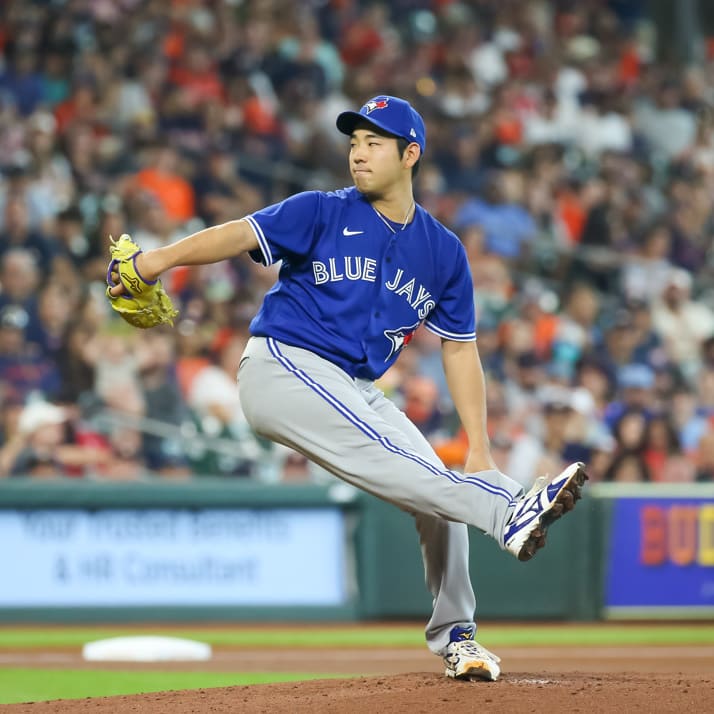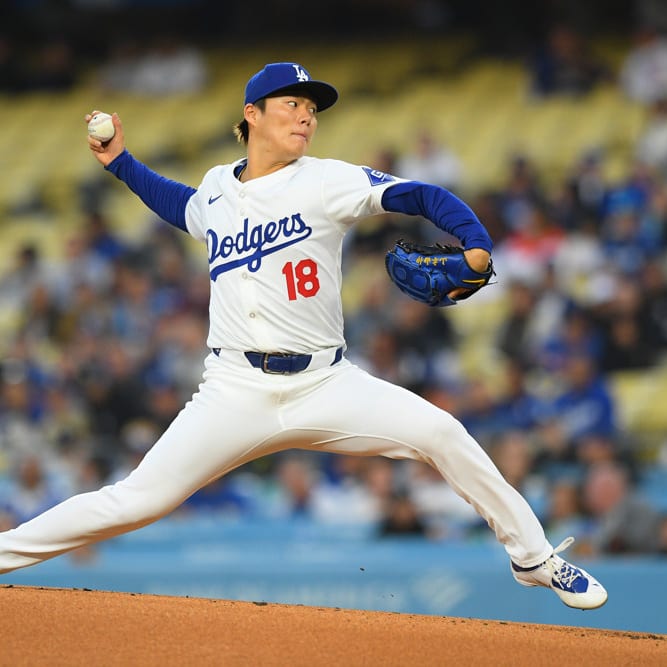This article is part of our Bogfella's Notebook series.
This Week's Scouting Tip: Which Pitch Can Make You Rich?
There are a lot of different pitches throw by professional baseball players. Various kinds of fastballs like the 2-seamer, 4-seamer, cutter and sinker, and a wide assortment of breaking pitches like the curve, slurve, and slider. Then you can add in straight changes, circle changes, and even knuckleballs and knuckle curves. And, there are many more beyond those mentioned. So, which pitch (or pitches) would be considered the ticket to a successful career as a major league hurler? Are there advantages to one over the others? Should you pay special attention to a guy who seems to be especially adept at throwing a specific pitch? These are all interesting questions, so let's have a go ...
Some examples:
There is a reason they call it the #1 ...
The fastball, in its various forms, is the most basic pitch in baseball. Not surprisingly, when you begin your evaluation of a pitcher, the velocity, movement and command of the fastball should be at the top of your checklist. But, the "fast" aspect is not the end all. Each component of the pitch combine to determine overall effectiveness - velocity is certainly nice, but without movement or without command, the pitch is typically not going to be a true asset. What makes velocity the first item on the checklist, is the difficulty associated with increasing the average speed of a fastball. When a player is very young, it's not uncommon to see
This Week's Scouting Tip: Which Pitch Can Make You Rich?
There are a lot of different pitches throw by professional baseball players. Various kinds of fastballs like the 2-seamer, 4-seamer, cutter and sinker, and a wide assortment of breaking pitches like the curve, slurve, and slider. Then you can add in straight changes, circle changes, and even knuckleballs and knuckle curves. And, there are many more beyond those mentioned. So, which pitch (or pitches) would be considered the ticket to a successful career as a major league hurler? Are there advantages to one over the others? Should you pay special attention to a guy who seems to be especially adept at throwing a specific pitch? These are all interesting questions, so let's have a go ...
Some examples:
There is a reason they call it the #1 ...
The fastball, in its various forms, is the most basic pitch in baseball. Not surprisingly, when you begin your evaluation of a pitcher, the velocity, movement and command of the fastball should be at the top of your checklist. But, the "fast" aspect is not the end all. Each component of the pitch combine to determine overall effectiveness - velocity is certainly nice, but without movement or without command, the pitch is typically not going to be a true asset. What makes velocity the first item on the checklist, is the difficulty associated with increasing the average speed of a fastball. When a player is very young, it's not uncommon to see his velocity improve; it's a manifestation of growth and added strength and conditioning. But, for a more mature pitcher, significant increases are rare (assuming the older pitcher is not rehabbing from an injury and even then they usually won't significantly exceed their pre-injury velocity).
Always remember, even with exceptional velocity (the average MLB fastball is in the low 90's), major league hitters can turn on a straight fastball, especially if the pitcher lacks command, and the pitch finds it's way to the middle of the plate. That said, the fastball ranks at the top of the money list simply because of it's impact on all the other offerings in a pitcher's arsenal. When a pitcher can spot his fastball inside and out or up and down in the zone, off-speed pitches are much more difficult to pick up, breaking pitches are more challenging to track, and those pitchers with exceptional velocity literally force a batter to key in on the fastball and adjust to anything else. Even "soft-tossers" typically use the fastball to set up their most reliable offerings. Throwing a "show me" fastball makes the batter aware of pitch while their off-speed pitches and breaking balls provide the illusion of more velocity on their fastball. It all comes together in keeping hitters guessing and off balance, and a fastball thrown to spots is the key to that equation.
There are some other pitches that often impact a pitcher's performance:
- Perhaps the defining characteristic of the most successful starting pitchers will be the ability to effectively change speeds. Therefore, developing a reliable change-up is paramount to making all of the pitches better. The key is arm speed. A change-up must look exactly like a fastball but arrive at an unanticipated time - preferably traveling 10 mph (or more) slower than the fastball. Timing is everything to hitting, and the combination of well-located fastballs and off-speed change-ups can very effectively disrupt the batter's timing.
- One of our favorite pitches is the cut fastball or cutter. Similar in movement to a slider, this pitch is thrown with less velocity and more movement than a fastball. The late breaking movement (like the change) is particularly helpful in handling hitters of the opposite hand. Think of a cutter as a slower fastball with more movement while a slider is a harder curveball with more movement. The big benefit to the cutter is it's reduced stress (less injury risk) on the pitchers arm.
- Perhaps the most entertaining pitch to watch is the curveball. Fans of pitching love the curve because if it is not what the hitter is expecting, it can make that hitter look rather awkward (read: foolish) and all pitching lovers enjoy that! The best curveballs break later and with sharper downward tilt.
- Lastly, let's talk about the sinker. This pitch is perhaps the most frustrating for fantasy players. When it's working, its devastating, when it's not (perhaps in the pitcher's next start) it can be like watching batting practice. Sinkerball pitchers have to resist the temptation to overthrow, which is why they are often vulnerable in the early innings when adrenaline can add a few inches to their signature pitch. A few inches added to a sinker means less time to sink and a sinker up in the zone can look like a beach ball to a MLB hitter.
Now, let's check this week's Scouting Notebook ...
This continues our regular weekly feature scouting pitchers of interest. Who should you be watching? Who is showing promise, and who is waving red flags? Each week we target specific games and provide readers with an analysis of key pitchers in those games. Alright, let's get started with this week's featured arms:
Ian Kennedy (ARZ)vs. CIN- Kennedy is a perfect example of using a wide array of pitches to provide very useful fantasy stats even though he does not have exceptional velocity on his fastball. Like most "finesse" pitchers, Kennedy uses his fastball to set up the pitches he relies on to shut down hitters. In his start against Cincinnati, he often showed the hitter a fastball out of the strike zone in the 89-91 range to create a platform for the change-up that served him well in an outstanding performance against one of the better hitting teams in the NL.
To be effective, Kennedy has to stay away from the middle of the plate while keeping his pitches down in the zone. His fastball can be a bit straight and has just average velocity so hitting spots with it is imperative. In our game, he threw a high percentage of change-ups, interestingly to both left and right-handed hitters. He was able to locate it well, and showed good movement down in the zone against lefties, but he was also letting it bore in on the hands of right-handed hitters. That's dangerous because it requires pinpoint accuracy, but Kennedy was on all night and routinely nailed his catcher's target. Although he did miss a couple of times (it's to be expected) the unseasonably cool weather in Arizona probably reduced the potential damage of balls hit in the air. Kennedy also mixed in a nice tight curve to give the Reds hitters one more thing to consider and the variation in speeds combined with good movement kept the lineup off balance throughout the game. We liked him a lot as a value pick coming into 2011 and his performance in this game only reinforced our positive expectations.
Overall, Kennedy appears to be establishing himself as a solid fantasy starter. He misses enough bats to generate a good strikeout rate and his command of the strike zone should limit walks and keep his WHIP on the satisfactory side of the ledger. That said, you can expect the occasional rough outing. He doesn't have overwhelming stuff so mistakes are a bit more problematic. The long ball, when he gets too much of the plate, can and will sometimes lead to big innings, especially in hitter-friendly Arizona.
Wade Davis (TB)@ CWS - Turning the page on this week's Scouting Notebook, we'll take a look at a pitcher who is pretty much the opposite of Ian Kennedy. While Kennedy can be considered a "finesse" pitcher, Wade Davis is all about power. However, against the White Sox, Davis didn't really consistently show us the power fastball and curve that are his primary weapons. When he's on, he can dial his fastball up into the mid 90s and his two-plane curve can be devastating. On this day, his velocity was down a bit, he struggled to command his fastball, and the curve was inconsistent.
Davis still managed to post a relatively good line - partially because RF Sam Fuld made one of the most amazing catches I have ever seen with the bases loaded - but he was not as sharp as he can be. Like we mentioned in our tips this week, a fastball is only as good as it's movement (which wasn't bad) and it's location (which was a recurring problem throughout the game). Compounding the situation, Davis still lacks a solid 3rd or 4th pitch to rely on when his best stuff isn't there. His change-up comes and goes, and while he did throw a couple of nice cutters, he does not appear confident in his ability to throw it to spots.
There is no question Davis has a very high ceiling, and he flashes some of that upside in almost every outing. He is still a bit of a two-pitch pitcher and that is a difficult scenario at the highest level of the game. His release point is inconsistent which results in pitches up in the zone, and when he fails to stay on top of the ball, his curve can flatten out and roll rather than break - a potentially highly volatile offering without some good luck.
You can probably expect inconsistency from Davis again this year. When in synch, he is capable of dominating, and his curveball will be a true strikeout pitch when he can vary his offerings more. He just needs to continue refining the command of his plus fastball and curve while developing more confidence in his change and cutter. He doesn't have quite the upside of David price, but his day will come, and it may not be too far off.
Erik Bedard (SEA)vs. CLE - Let's try a more difficult scouting assignment. Bedard made his 2nd start of 2011 at home against the Cleveland Indians. More importantly, it was just his 2nd start in nearly 2 years. The line was brutal - 4 IP, 10 hits and a walk, 6 earned runs, and 6 punch-outs. Send him to the waiver wire, right? Not quite yet, let's not be quite so quick to dismiss this former ace. While his 1st 2 starts back have been short and relatively ugly, there were some very positive signs.
In his glory days, Bedard was a 2-pitch pitcher - a 91-93 mph fastball with movement and a devastating curve, the best in baseball according to some talented hitters. He experimented with a slider but basically abandoned it (probably a good idea given his fragile shoulder), but he lived with the smoke and knee-benders. However, the 2011 version is a bit different. His percentage of fastballs is way down, he is even throwing fewer curves, and he now throws a change-up and an occasional cutter. That suggests an evolution from thrower to pitcher and at this stage of his career, it's a good plan.
Against Cleveland, Bedard lacked consistent command ... in other words there is still plenty of rust from the long layoff. And, now throwing less familiar pitches, the command issues were compounded. Despite the disappointing line, his fastball was in the low 90s and his curve generally had a lot of tilt. They just weren't consistent. When he hit his spots, especially when he pitched inside, he was strong and missed a lot of bats (don't forget the 6 strikeouts). Too often, he was up in the zone with the fastball and change, and he missed out over the plate with the fastball and a few curves. Combined with a little bad luck and sloppy fielding, the hard hit balls did quite a bit of damage.
He will likely be dropped in many leagues based on these 2 less than impressive starts, but we will consider that an opportunity. He is not all the way back, and he is certainly an injury risk given his history. However, he threw quite a few pitches that were reminiscent of his 2006-2007 seasons. If he can successfully transition to more of a pitcher to compliment the nasty stuff, he could be a force. A plus, his motion was free and easy suggesting he may be past the injuries, so we will have to hope he can stay healthy.
Some short takes:
John Lackey (BOS)- He is really scuffling and is symptomatic of the Red Sox poor start. He did get a win last Friday, however it was the offense and not his pitching that propelled the first Boston victory of the year. He was not a good fantasy option last year and hasn't show much to suggest he will be in 2011.
Jair Jurrjens (ATL)- Jurrjens is expected back at the end of this week. The Braves were cautious in bringing him along after he suffered a minor injury in spring training, however he is someone we expect to see bounce back from a disappointing 2010. He could be hiding on your waiver wire and if he is available, we would be buyers.
Matt Thornton (CWS) - Getting an opportunity to close, one of the better set-up men in the game has struggled early this season. He is probably not in serious danger of losing the job just yet, but Sergio Santos or Chris Sale could see some save opps in the near future. Santos lacks experience, but has the stuff if you can stash him on your bench.
Kid's Corner ...
Ross Detwiler (WAS)- While the Nats begin the season with lower upside starters in their MLB rotation, Detwiler got off to a good start at Triple-A with 6 IP allowing 4 hits with 1 walk and 8 strikeouts. He should be up before too long and will be a nice addition to the Nats staff, both this year and for the future.
For some of the most in-depth coverage of all things pitching in fantasy baseball for 2011, visit www.bogfella.com and be sure to follow @RotoWire and @bogfella on Twitter.










